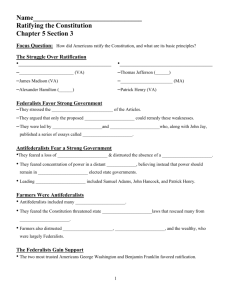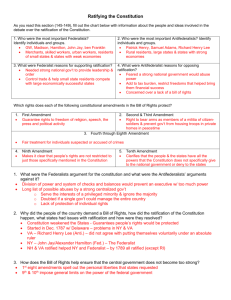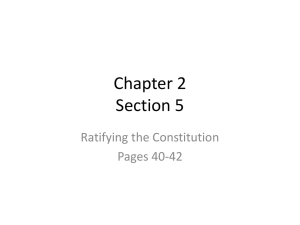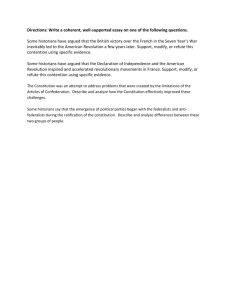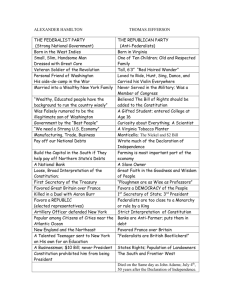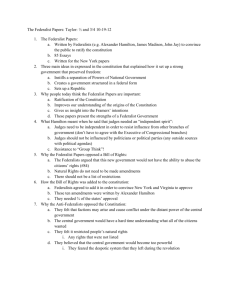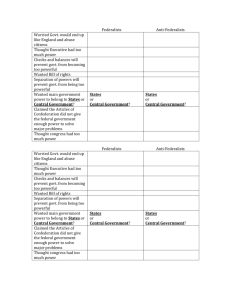000A
advertisement
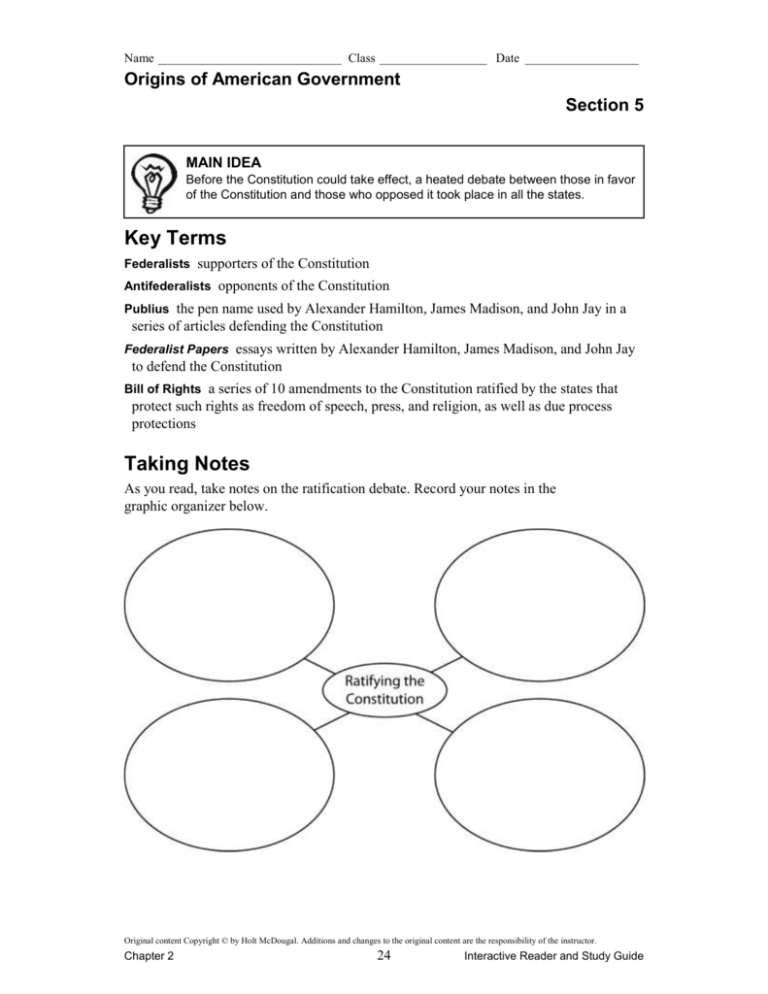
Name _____________________________ Class _________________ Date __________________ Origins of American Government Section 5 MAIN IDEA Before the Constitution could take effect, a heated debate between those in favor of the Constitution and those who opposed it took place in all the states. Key Terms Federalists supporters of the Constitution Antifederalists opponents of the Constitution Publius the pen name used by Alexander Hamilton, James Madison, and John Jay in a series of articles defending the Constitution Federalist Papers essays written by Alexander Hamilton, James Madison, and John Jay to defend the Constitution Bill of Rights a series of 10 amendments to the Constitution ratified by the states that protect such rights as freedom of speech, press, and religion, as well as due process protections Taking Notes As you read, take notes on the ratification debate. Record your notes in the graphic organizer below. Original content Copyright © by Holt McDougal. Additions and changes to the original content are the responsibility of the instructor. Chapter 2 24 Interactive Reader and Study Guide Name _____________________________ Class _________________ Date __________________ Section 5 continued Section Summary ANTIFEDERALISTS VERSUS FEDERALISTS The Framers were aware that the existing Congress and state legislatures would not be happy with the new, stronger national government they were proposing. Therefore, they had included a process for ratifying the Constitution that would bypass both groups, instead calling for voters to elect representatives to a state ratifying convention. The Constitution would become law once 9 of the 13 states ratified it. The battle for ratification involved the Antifederalists, the opponents of the Constitution, and Federalists, the supporters of the Constitution. Antifederalists claimed that the national government proposed by the Constitution would become too strong and threaten republicanism and state sovereignty. They also criticized the absence of a bill of rights, without which they feared the new national government could violate personal civil liberties with no fear of punishment. Federalists countered that a sufficiently powerful national government would strengthen the union of the states and have the power to defend the nation against foreign enemies, regulate trade, and control internal disturbances like the earlier Shays’s Rebellion. Federalists also highlighted how the separation of powers officially limited federal power. THE FEDERALIST PAPERS In order to summon more support for ratification, prominent Federalists James Madison, Alexander Hamilton, and John Jay, under the pen name Publius, wrote the Federalist Papers, a series of articles defending the Constitution for New York newspapers. The 85 articles—each of which discussed principles underlying the Constitution, such as checks and balances—were collected into a single volume of essays and widely circulated, strongly influencing the ratification debate. Antifederalists responded with essays of their own that frequently addressed the importance of liberty and the guarantee of “unalienable and fundamental rights.” What arguments did Antifederalists make against ratifying the Constitution? _______________________ _______________________ What was the point of the Federalist Papers? _______________________ _______________________ Original content Copyright © by Holt McDougal. Additions and changes to the original content are the responsibility of the instructor. Chapter 2 25 Interactive Reader and Study Guide Name _____________________________ Class _________________ Date __________________ Section 5 continued THE FIGHT FOR RATIFICATION The Federalists had been better prepared for the fight over ratification than the Antifederalists, quickly pointing out to small states that they would have equal representation in the Senate, despite their small populations. Yet Federalists found the largest and most powerful states difficult to persuade. Federalists finally agreed to the Antifederalists’ demand for a bill of rights. This change had a remarkable effect on ratification. On June 21, 1788, the ninth state ratified the Constitution, and the remaining 4 states ratified it shortly thereafter. Once the first Congress met, James Madison emphasized that the promised bill of rights should be proposed and ratified quickly. Madison suggested a number of amendments, or changes to the Constitution, that reflected earlier declarations of rights, including the English Bill of Rights and the Declaration of Independence. In September 1789, Congress sent 12 amendments to the states for ratification. By December 1791, the states had ratified 10 of the amendments. Traditionally called the Bill of Rights, these 10 amendments protect a number of civil liberties and civil rights, including the freedom of speech, press, and religion. How was the Bill of Rights added to the Constitution? _______________________ _______________________ Original content Copyright © by Holt McDougal. Additions and changes to the original content are the responsibility of the instructor. Chapter 2 26 Interactive Reader and Study Guide
